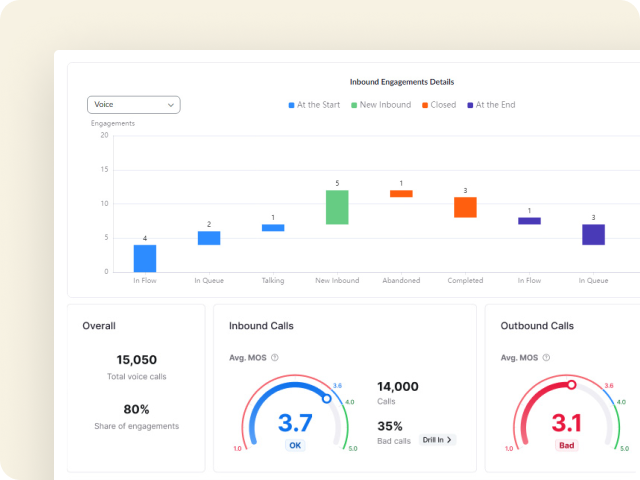Creating an exemplary customer service experience is essential to encourage brand loyalty and boost revenue.
“Contact centres play a key role in the customer experience because the interactions they participate in are often critical points in the journey,” Greg Kihlstrom, martech advisor and principal at The Agile Brand, tells Sifted.
“Often, contact centres are handling complaints or other issues that arise, or they are assisting in the completion of a purchase. Because of this, the interactions can be particularly memorable and the outcomes or overall experience can have an outsized impact on the customers' view of the brand.”
How can resource-stretched startups build a contact centre that ticks all the boxes? We took a look at building a contact centre at a startup — and the significant role AI can play.
An omnichannel approach
Research by IDC and Zoom found that email leads the way when it comes to digital channels used for brand engagement in Europe, with 62% of businesses utilising it for their contact centres. Phone/voice and website contact forms followed closely, with 57% and 52% respectively. SMS was flagged as the least popular option at 29%.
“The main thing that a customer contact centre can’t be, is closed,” says Ben Neo, head of CX sales at Zoom, which added an AI chatbot to its contact centre this year. “In the current world, we need to be omnichannel and have the ability to start [an interaction] on one channel and move to another as customers like working across different channels.”
The main thing that a customer contact centre can’t be, is closed.

For instance, Zoom’s contact centre offers voice, SMS, web chat and video, which customers can self-serve 24/7.
“Organisations need to work out what type of customer they are trying to engage, how that customer likes to engage, and then make sure that they provide the service that enables a customer to do it,” recommends Neo, who specifically notes the important role video has in customer interactions of all types, but particularly in industries like health and finance that are more personal and require an element of trust for interactions.
“Video is one of those channels where it’s location independent, but it’s still human touching,” he says. “There’s still human engagement there, and having a contact centre that embraces video means agents can read body language and react to that.”
This view of prioritising a personable approach is one shared by Steven Van Belleghem, who is author of multiple books on customer experience including ‘A Diamond in the Rough’.
“It’s important that a customer feels that they’re not just going through a fixed script,” he says. “But that they are understood and that it can be a moment where you can share a complaint or another emotion, and that the person in the contact centre shows empathy — and then helps you out with a solution that is sufficient.”
Embracing AI
AI is already being used by businesses for their customer service offering in the form of chatbots, but Neo says its role in contact centres goes far beyond that — and, perhaps most importantly, works alongside human agents to propel their capabilities.
“The agent’s job is difficult because the information a customer is asking for might consist of two or three different things sitting on different systems,” he says. “AI can find that information quickly and surface it to the agent. Then, it’s up to the agent to determine if it’s useful.”
AI recognises who you are, what you’ve done previously, what you might want to do next, and it’s telling the agent all of this to make sure that they can deliver a much better personalised experience.
This opportunity for human agents and AI to work together is an important capability for cash- and resource-strapped startups. AI can take the burden of simple customer queries — like opening hours — away from human agents, freeing up their time to respond to more complex cases. This avoids a need for founders to invest in extra talent to respond to customer queries, or the scenario of leaving customers waiting for long stretches of time.
According to Zoom, 68% of Zoom Virtual Agent (a conversational AI and chatbot) interactions are self-service on average.
“AI recognises who you are, what you’ve done previously, what you might want to do next, and it’s telling the agent all of this to make sure that they can deliver a much better personalised experience if [the case] comes to the agent,” says Neo. “If [the interaction] is purely done on a digital channel, a digital chatbot can also create a personalised journey as well that ultimately gets the customer to the right place.”
All of this means agents are at the centre of a customer’s experience with a business, so it’s crucial to consider their position when building out a contact centre.
“Don’t just deliver the technology and expect the agent to work with it,” says Neo. “Involve the agents in the buying decision and ask them what’s useful, because they’re the people that have to work with it — but they’re often not told why and what the benefit is to them.”
Valuable analytics
AI in contact centres is also helping to generate insightful data that can be used to enhance service offerings to customers.

Analytics have become critical for driving a quality service for customers, with the IDC report noting how AI-infused analytics are making it possible for organisations to identify gaps and opportunities, and obtain detailed insights from the granular data.
It found that 29% of businesses have already invested in AI and automation, flagging the additional connection of data for 360-degree views of customers and the use of analytics to ensure service quality and customer satisfaction as the leading factors driving customer experience success in contact centres. Admins in Zoom’s contact centre, for example, have access to real-time analytics — which can be used in the moment or during later analysis.
“Using predictive analytics, AI can assess if a customer is likely to churn, or if there may be opportunities to grow an account, which can provide a contact centre employee with critical information that can improve the relationship,” says Kihlstrom. “AI can also use its data analysis capabilities to determine larger trends and issues that the business can use to anticipate issues and ideally solve key disconnects in the customer experience.”
Experience Zoom Contact Centre
Connect with a Zoom expert today and experience the benefits of a cloud contact centre solution.




